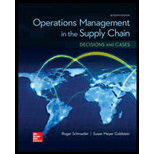
Concept explainers
a)
To draw: A cause and effect diagram for the given situation.
Introduction:
Cause and effect diagram:
It is a diagrammatic tool used to identify different causes for a problem. It visually displays the various causes for a problem and its consequent effect.
b)
To draw: A cause and effect diagram for the given situation.
Introduction:
Cause and effect diagram:
It is a diagrammatic tool used to identify different causes for a problem. It visually displays the various causes for a problem and its consequent effect.
c)
To draw: A cause and effect diagram for the given situation.
Introduction:
Cause and effect diagram:
It is a diagrammatic tool used to identify the different causes for a problem. It visually displays the various causes for a problem and its consequent effect.
Want to see the full answer?
Check out a sample textbook solution
Chapter 9 Solutions
OPERATIONS MANAGEMENT IN THE SUPPLY CHAIN: DECISIONS & CASES (Mcgraw-hill Series Operations and Decision Sciences)
- In organizational development when results are improving but relationships are declining, what leadership style is appropriate? directing delegating supporting coachingarrow_forwardWhat is the first thing a leader should do when moving through a cultural change? conduct an assessment comparing the practices to other high-performing organizations learn about the current organizational culture continue to monitor key metrics define expectationsarrow_forwardThe third change leadership strategy, Collaborate on Implementation, is designed to address what type of concerns? impact concerns personal concerns refinement concerns collaboration concernsarrow_forward
- If team members are concerned with specifics such as their tasks, contingency plans, resources, and timeline, what concerns do they have? implementation concerns impact concerns refinement concerns personal concernsarrow_forwardAt the developing stage of organizational development, which leadership style is most appropriate? supporting coaching delegating directingarrow_forwardDuring the start-up phase of organizations, which leadership style is appropriate? supporting coaching directing delegatingarrow_forward
- Regarding relationships and results, what is typically seen in start-up orgnanizations? low results/high relationships low results/low relationships high results/high relationships high results/ low relationshipsarrow_forwardWhat issues lie within Employee and Labor relations with hours worked and how to solve the issues effectively.arrow_forwardName the key stakeholders in the case. Consider the stakeholder map in the lecture material. Which stakeholders would be the most important under your default lens?arrow_forward
- research Walmart as chosen organization through primary and secondary sources, investigate the organization's mission and vision statement and code of ethics. What is a potential social cause that can be recommend to Walmart that is different than any current social cause Walmart pursues. Research a variety of sources, including the Walmarts website, social media sites, company blogs, industry and trade sources, and other sources, provide a summary of the organization, including Walmarts products or services, customer or client base, areas of operation or distribution, history, main competition, and the organization's current situation. Analyze the mission, vision, and values of Walmart. Evaluate the ethical principles and policy under which Walmart works.arrow_forwardRead Himachal Fertilizer Corporation (B) and critique the decision he actually made after reading Part B. Was your recommendation similar to what Neil did...how was it the same or how did it differ? Explain why with details from course materials and the case.arrow_forwardName the key stakeholders in the Himachal Fertilizer Corporation Part A case. Consider the stakeholder map in the image below. Which stakeholders would be the most important under your default lens?arrow_forward
 Practical Management ScienceOperations ManagementISBN:9781337406659Author:WINSTON, Wayne L.Publisher:Cengage,
Practical Management ScienceOperations ManagementISBN:9781337406659Author:WINSTON, Wayne L.Publisher:Cengage, Management, Loose-Leaf VersionManagementISBN:9781305969308Author:Richard L. DaftPublisher:South-Western College Pub
Management, Loose-Leaf VersionManagementISBN:9781305969308Author:Richard L. DaftPublisher:South-Western College Pub- MarketingMarketingISBN:9780357033791Author:Pride, William MPublisher:South Western Educational Publishing



